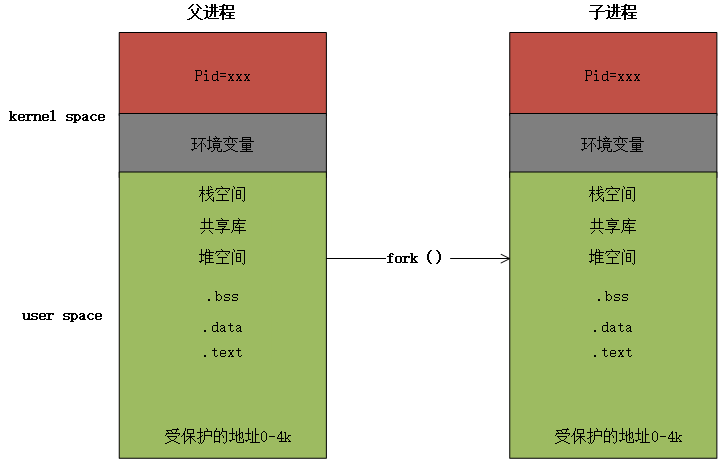Linux的Fork笔记
Linux的Fork笔记
fork()函数虽然用法比较固定,但是其若成功调用一次则返回两个值,子进程返回0,父进程返回子进程ID。对于fork自己还是有一些不理解的地方,特用该文档帮助自己理清一下思绪。
fork的作用
在Linux机器中输入命令info fork可以得到关于fork的描述大致如下:
fork() creates a new process by duplicating the calling process. The new process is referred to as the child process. The calling process is referred to as the parent process.
The child process and the parent process run in separate memory spaces. At the time of fork() both memory spaces have the same content. Memory writes, file mappings (mmap(2)), and unmappings (mun‐map(2)) performed by one of the processes do not affect the other.
即一个现有进程调用fork函数可以创建一个新进程,新进程叫做子进程,fork函数特点为调用一次返回两次。
子进程是父进程的副本,子进程拥有父进程的数据空间、堆、栈等资源的副本,父子进程共享的存储空间只有代码段。
fork函数所需的头文件:
#include <sys/types.h>
#include <unistd.h>
fork返回值:
- 若成功创建一个子进程,对于父进程来说返回子进程ID;
- 若成功创建一个子进程,对于子进程来说返回子进程ID;
- 返回-1即创建失败;
简单例子:
#include <stdio.h>
#include <sys/types.h>
#include <unistd.h>
int main() {
int pid = 1;
pid = fork();
if (pid == 0)
printf("child process\n");
else if (pid > 0)
printf("parent process\n");
else
printf("fork failed!]n");
printf("test\n");
return 0;
}
// 输出结果
parent process
test
child process
test
子进程在
fork之后开始向下执行,而不会从头开始执行,fork把原来的进程的所有值都复制到新的新进程中,只有少数值与原来的进程的值不同;
每个进程都有一个唯一的进程标识符process ID,可以通过getpid()函数获得,还有一个记录父进程pid的变量,可以通过getppid()函数获得变量的值;
fork的原理
简而言之,当一个进程调用fork()函数后,系统先给新的进程分配资源,例如存储数据和代码的空间。然后把原来的进程的所有值都复制到新的新进程中,只有少数值与原来的进程的值不同。
Linux 的fork() 是通过写时拷贝 copy-on-write)实现的,写时拷贝是一种可以推迟甚至避免拷贝数据的技术。内核此时并不复制整个进程的地址空间,而是先让父子进程共享同一个地址空间,只有子进程在需要写入的时候才会复制地址空间,从而使各个进行拥有各自的地址空间。也就是说,资源的复制是在需要写入的时候才会进行,在此之前,以只读方式共享地址空间,地址拷贝可以参考下图。

多层fork问题:
#include <unistd.h>
#include <stdio.h>
int main(void)
{
int i=0;
for(i=0;i<2;i++){
pid_t fpid=fork();
if(fpid==0)
printf("son\n");
else
printf("father\n");
}
return 0;
}
问调用了几次printf函数?
作者:醉曦
欢迎任何形式的转载,但请务必注明出处。
限于本人水平,如果文章和代码有表述不当之处,还请不吝赐教。



【推荐】国内首个AI IDE,深度理解中文开发场景,立即下载体验Trae
【推荐】编程新体验,更懂你的AI,立即体验豆包MarsCode编程助手
【推荐】抖音旗下AI助手豆包,你的智能百科全书,全免费不限次数
【推荐】轻量又高性能的 SSH 工具 IShell:AI 加持,快人一步
· 终于写完轮子一部分:tcp代理 了,记录一下
· 震惊!C++程序真的从main开始吗?99%的程序员都答错了
· 别再用vector<bool>了!Google高级工程师:这可能是STL最大的设计失误
· 单元测试从入门到精通
· 【硬核科普】Trae如何「偷看」你的代码?零基础破解AI编程运行原理
2019-09-20 day 5